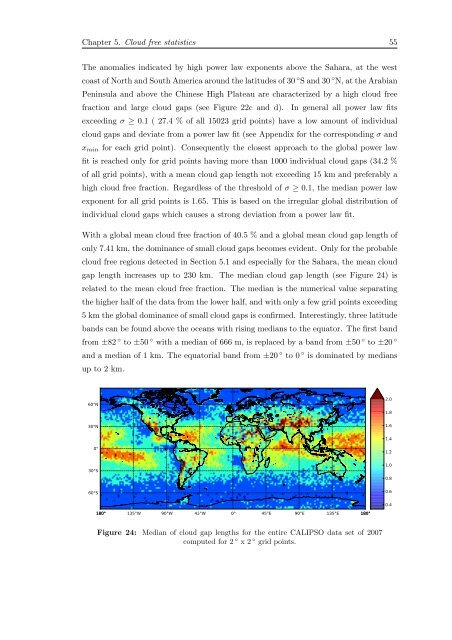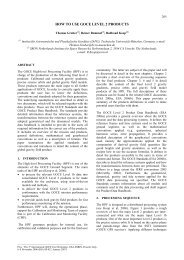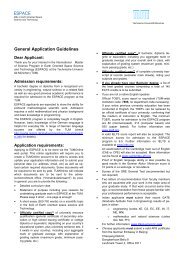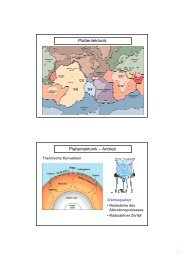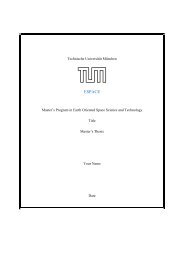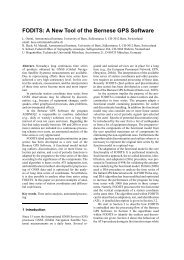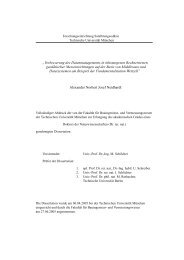Cloud Statistics from Calipso Lidar Data for the ... - espace-tum.de
Cloud Statistics from Calipso Lidar Data for the ... - espace-tum.de
Cloud Statistics from Calipso Lidar Data for the ... - espace-tum.de
Create successful ePaper yourself
Turn your PDF publications into a flip-book with our unique Google optimized e-Paper software.
Chapter 5. <strong>Cloud</strong> free statistics 55<br />
The anomalies indicated by high power law exponents above <strong>the</strong> Sahara, at <strong>the</strong> west<br />
coast of North and South America around <strong>the</strong> latitu<strong>de</strong>s of 30 ◦ S and 30 ◦ N, at <strong>the</strong> Arabian<br />
Peninsula and above <strong>the</strong> Chinese High Plateau are characterized by a high cloud free<br />
fraction and large cloud gaps (see Figure 22c and d). In general all power law fits<br />
exceeding σ ≥ 0.1 ( 27.4 % of all 15023 grid points) have a low amount of individual<br />
cloud gaps and <strong>de</strong>viate <strong>from</strong> a power law fit (see Appendix <strong>for</strong> <strong>the</strong> corresponding σ and<br />
x min <strong>for</strong> each grid point). Consequently <strong>the</strong> closest approach to <strong>the</strong> global power law<br />
fit is reached only <strong>for</strong> grid points having more than 1000 individual cloud gaps (34.2 %<br />
of all grid points), with a mean cloud gap length not exceeding 15 km and preferably a<br />
high cloud free fraction. Regardless of <strong>the</strong> threshold of σ ≥ 0.1, <strong>the</strong> median power law<br />
exponent <strong>for</strong> all grid points is 1.65. This is based on <strong>the</strong> irregular global distribution of<br />
individual cloud gaps which causes a strong <strong>de</strong>viation <strong>from</strong> a power law fit.<br />
With a global mean cloud free fraction of 40.5 % and a global mean cloud gap length of<br />
only 7.41 km, <strong>the</strong> dominance of small cloud gaps becomes evi<strong>de</strong>nt. Only <strong>for</strong> <strong>the</strong> probable<br />
cloud free regions <strong>de</strong>tected in Section 5.1 and especially <strong>for</strong> <strong>the</strong> Sahara, <strong>the</strong> mean cloud<br />
gap length increases up to 230 km. The median cloud gap length (see Figure 24) is<br />
related to <strong>the</strong> mean cloud free fraction. The median is <strong>the</strong> numerical value separating<br />
<strong>the</strong> higher half of <strong>the</strong> data <strong>from</strong> <strong>the</strong> lower half, and with only a few grid points exceeding<br />
5 km <strong>the</strong> global dominance of small cloud gaps is confirmed. Interestingly, three latitu<strong>de</strong><br />
bands can be found above <strong>the</strong> oceans with rising medians to <strong>the</strong> equator. The first band<br />
<strong>from</strong> ±82 ◦ to ±50 ◦ with a median of 666 m, is replaced by a band <strong>from</strong> ±50 ◦ to ±20 ◦<br />
and a median of 1 km. The equatorial band <strong>from</strong> ±20 ◦ to 0 ◦ is dominated by medians<br />
up to 2 km.<br />
60°N<br />
30°N<br />
2.0<br />
1.8<br />
1.6<br />
1.4<br />
0°<br />
30°S<br />
60°S<br />
180° 135°W 90°W 45°W 0° 45°E 90°E 135°E<br />
180°<br />
1.2<br />
1.0<br />
0.8<br />
0.6<br />
0.4<br />
Figure 24: Median of cloud gap lengths <strong>for</strong> <strong>the</strong> entire CALIPSO data set of 2007<br />
computed <strong>for</strong> 2 ◦ x 2 ◦ grid points.


